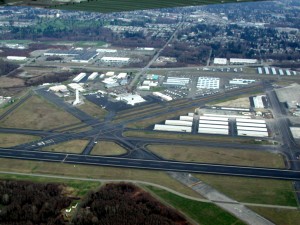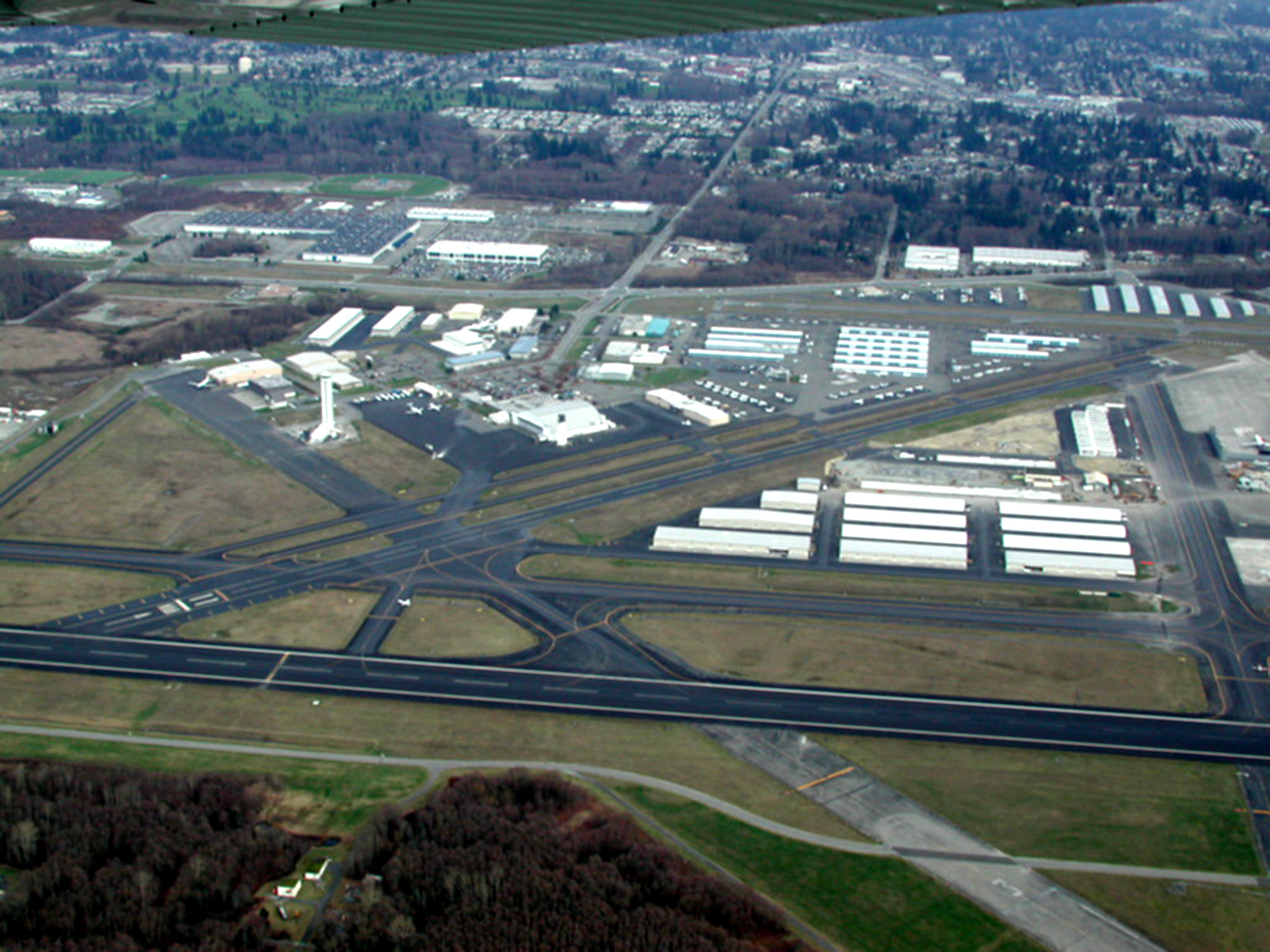
Paine Field may soon attract airline passenger service, as Snohomish County population grows to nearly a million people by 2025. The county’s current population is 660,000.
By Terry Stephens
A deadlocked panel of citizens, including both supporters and opponents of bringing airline service to Snohomish County Airport/Paine Field (PAE), in Everett, Wash., has passed the politically hot issue to the county’s elected officials for a decision. The Snohomish County Council will get the panel’s complete report on their desks by late January.
Since 1978, a Mediated Role Determination document, negotiated by anti-airport growth groups and the county government, has been the county’s official policy, focused on discouraging anything but general aviation growth at the airfield. For nearly three decades, however, numerous changes have eroded the MRD’s questionable position.
To begin with, the anti-air carrier policy was only a governing document, and never an official law or limitation to airport growth. It was weakened even more in 1996 when Washington declared airports to be economic resources.
Also, growth at the Boeing assembly plant adjacent to Paine Field expanded 747 production to include 767s and 777s, so large, multi-engine aircraft brought increased noise to the airport. This year, the new 787 begins production there. Paine Field is no longer simply a GA airport. Add to that mix the airliners that come and go to Goodrich Aviation Services’ huge airliner maintenance center at Paine Field.
In 2005, when nearby residents and communities told county officials they wanted stronger regulations than the MRD to block airlines from bringing air service to Paine Field, Snohomish County Executive Aaron Reardon created a local citizens panel to examine the wording of the 1978 MRD, to see if it could be made more enforceable.
But in late December, after more than a year of study, discussion and debate by the citizens’ panel, the group remains as divided as when discussions began. Both sides concluded it’s the responsibility of the elected Snohomish County Council to find a way to update the MRD or finally end its role as an unofficial restriction on Paine Field.
The panel also recommended that the county rely on its comprehensive planning process, mandated by the state’s Growth Management Act, as well as the airport master planning processes, mandated by the Federal Aviation Administration, to determine future land use and operations at Paine Field.
Peter Camp, Snohomish County executive director, who moderated the discussion, said he would finish his report by late January and forward it to the county council for a decision. The report will state that both sides agree the MRD’s effort to limit air carriers’ use of the airport is a moot issue, in light of new federal regulations approved in recent years. The laws prohibit the Snohomish County government from discriminating against any airline request to establish service there.
No airline is presently expressing interest, but if that changes, the move can’t be stopped. Many observers feel that with county growth expected to increase by some 300,000 people by 2025, and with freeway access to Seattle-Tacoma International Airport already severely congested, airlines may decide to open facilities at Paine Field.
Federal aviation laws take precedent
Ironically, when the MRD was created in 1978, the new federal Airline Deregulation Act limited the authority of local governments to regulate most aspects of air carrier operations. In 1990, the federal Airport Noise and Capacity Act went a big step further. It prohibited airports from “imposing noise or access” restrictions on airlines, since the government had mandated that airlines fly much quieter aircraft by 2000, in order to reduce noise for adjacent communities.
Also in 1990, Washington adopted the Growth Management Act, which considers airports to be “essential public facilities” that are to be managed for the benefit of the state’s citizens. Those factors and others contributed to the impasse that resulted when the citizens’ panel was asked to decide whether, and how, to reword the language and intent of the MRD.
Each side praised the other’s civility during the discussions of the emotionally-charged issue, but panel members, who supported airline service as a way of boosting the county’s economy, remain at odds with members of Mukilteo, Wash.-based Save Our Communities. Representatives of several south county communities fear that airline service would bring excessive noise and lowered property values and quality of living. Throughout the discussions, Gregory Hauth, president of the nonprofit group, maintained the MRD is a “social contract.”
“By exploring the possibility of scheduled airline service at Paine Field, Snohomish County is casting aside an agreement it made 27 years ago with residents and property owners,” Hauth said.
He said those who bought homes and invested in businesses near the airport based their decisions “on the assumption that the county could be relied upon to keep its word,” and said those people are feeling betrayed.
Five cities in the county have approved resolutions opposing air passenger flights, and each has a representative on the MRD review panel.
Paine Field must be ready for airlines
During the group’s final meeting on Dec. 14, seven panel members said the MRD is legally unenforceable and should no longer be used as a policy guide. Several explained why they support scrapping the MRD and preparing for airline service when it arrives.
“Discussions about commercial air service and the MRD often fail to recognize the broader role that Paine Field plays in the region, state and even national economy,” said Paul Roberts, Everett city councilman and former Snohomish County executive director. “Paine Field may be the most significant public economic asset in Snohomish County, as it’s necessary for the aerospace industry,” Roberts said.
He noted that the Washington Legislature, too, recognized that importance by designating Paine Field and other airports as economic resources that should be protected.
“In 1996, years after the 1978 MRD agreement was reached, the state required local jurisdictions to adopt plans and regulations to protect airports. Protecting air operations at Paine Field is in the public interest,” Roberts said.
Opponents pointed out that noise issues at the airport would remain an issue if air carriers came to Paine Field, but supporters said existing airport noise limits have already reduced high decibel levels to within airport boundaries. Years ago, noise patterns for aircraft taking off extended several miles north of the airport. Also, new engines on late model planes now make airliners far quieter than the 747s and other airliners presently flying from Paine Field.
John Shaw, businessman and attorney; Hugh Townsend, president and CEO of Reid Middleton of Everett; and Mark Wolken, Everett consultant, presented a joint statement, urging that the MRD be abandoned. At an earlier meeting in December, Shaw told the group that airport policy should be written into agreements that have legal standing, such as airport master plans and regional planning documents. He said “the market” should decide whether commercial flights come to Paine Field, not the outdated and debatable MRD agreement, which has no legal status.
Tom Hoban, CEO of Coast Real Estate Services in Everett, said his experience in dealing with businesses, jobs and real estate developments in Snohomish County have convinced him that “closer and more convenient access to commercial (air) passenger service” would generate more economic growth, which would benefit the entire county.
In recent years, others, too, have urged development of air carrier service at Paine Field, citing it as a benefit to the economy. Among those supporters was Reardon’s own Citizens Cabinet on Economic Development, which called Paine Field a significant economic asset. The cabinet members recommended air service be developed to attract more economic development and to provide more convenience for air travelers who now face lengthy trips to Sea-Tac in heavily congested traffic.
After the panel’s report is submitted to the Snohomish County Council in late January, the former Mediated Role Agreement could well become a far more positive guideline for developing air carrier and other services at Paine Field.











